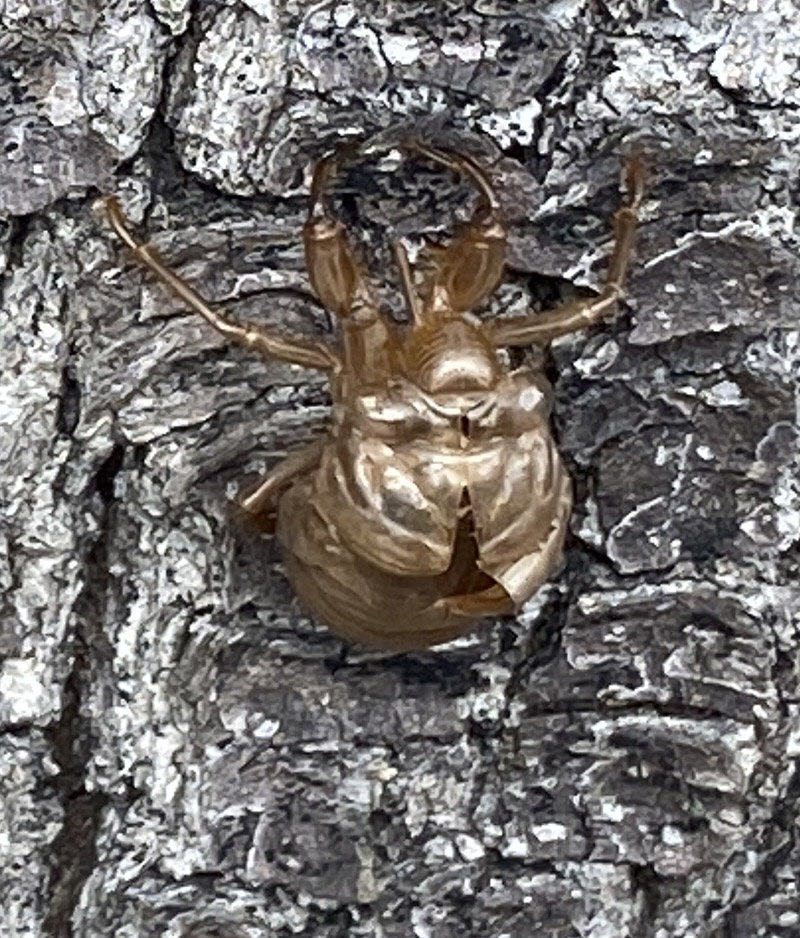By Pat Foster-Turley
September 23, 2021

I’m sure most of you have heard the loud buzzing sounds at night emanating from the trees this time of year. It’s cicada season here in north Florida. Unlike in some States further north, our cicada visits are an annual event, not the hordes of bugs emerging periodically every 13 or 17 years that have overrun some areas.
I must admit, sometimes I tune out the cicada sounds in my backyard and don’t even hear them, sort of like living by a train track and ignoring the sound of trains. But a recent nature event at Harris Teeter grocery store reminded me of their presence once again.
I was merrily shopping, greeting both employee and fellow customer friends when someone called out, “Pat, there’s a lizard over here!” Sure enough a Cuban anole was waiting in line near the checkout counter and I quickly abandoned my groceries, scooped it up and delivered it to a grassy area under a tree in the parking lot. But I didn’t make it right back into the store. I got captivated by all that was happening on the tree bark. When I set the lizard on the ground another anole sprung down to chase it and they both scurried up the tree past the air plants that were living on the tree bark too. That’s when I noticed the shed cicada exoskeleton on the tree bark. When the cicada’s leave their last adult stage to fly again and mate, they leave their old skin behind. If you look at the outside walls of your house, or trees nearby you just might find these too. When I finally got back inside the store, my groceries were waiting for me, stuck behind a few other people that took my place in line when I disappeared. No problem.

Another bug incident inspired me this week too. Some friends and I were meeting at the Dee Dee Bartels Boat Ramp pavilion for a Covid-safe outdoor picnic lunch. I got there first, spread out a tablecloth and waited for the others. Across the parking lot I saw my friends from Pennsylvania getting out of their car. And wow, what a hubbub that was! One friend, who will remain nameless, encountered a horde of lovebugs and quickly got out her insect repellent and started spraying them while trying to brush them away from her. Good luck with that!
When she finally arrived at the pavilion we longer term Florida residents were nonchalantly brushing aside the paired lovebugs that had found the picnic area too. But we long-timers knew that these insects were nothing to worry about. Every year there is a bloom of lovebugs that hitch themselves together to mate, sometimes for a few days, then get crushed on our windshields or die elsewhere. They are a nuisance for sure, but not harmful to humans except for the mess left behind on our cars. Although there is a long standing rumor that the University of Florida released lovebugs years ago to eat mosquitos this is not true. Like many other species in our midst, these got here naturally through extensions of their original home ranges. And no, they don’t even eat mosquitos, but only decaying vegetation.
If you have a white car like my picnicking friend has, you are more likely to see them on your parked vehicle, but any vehicle can get covered with them just driving on the highway. If you find them on your car get them off quickly before they decompose and become increasingly more difficult to remove. Google “removing lovebugs from car” to find out lots of proven and unproven ways to do this. Doing it quickly when you encounter them is key.
While they are here, though, take a closer look and you can even tell the males, usually smaller, than the females which are usually larger with a smaller head. Soon, though, this season’s swarm of lovebugs will be history until the next year so look at them while you can. Soon, like the harmless cicadas, they will disappear from our lives once again.
Pat Foster-Turley is a zoologist on Amelia Island. She welcomes your nature questions and observations. [email protected]
